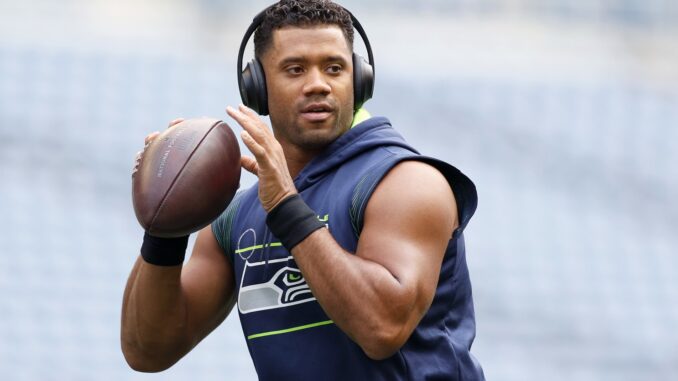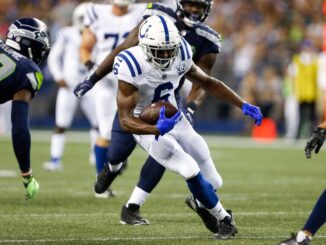
A new season looms on the horizon! We are less than two weeks away from the first regular season game on Thursday, September 9th. And just three days later – Seattle, Los Angeles, Arizona, and San Francisco hold their first games on Sunday, September 12th. We will see Arizona, Seattle, and San Francisco travel on the road in the morning to take on Tennessee, Indianapolis, and Detroit. Then on Sunday night, the Rams host Chicago to close out the week one schedule.
After that, it’s just seventeen weeks to go before a division winner is crowned. That’s right, in case you were living under a rock this past offseason – the NFL will have an 18-week regular season for the very first time this year. So once these teams take care of business in week one, there are still seventeen weeks to go – one of them is still a bye week. You may have noticed that there are only three preseason weeks this year, and that’s not an accident. Each team is only allowed to participate in a total of 20 games per season (playoffs do not enter into this part of the equation), so to extend the regular season, the league had to eliminate a week of preseason. So the coming week is a week off by design – it’s technically an extra bye week before the season actually starts.
Another new twist – since there is an odd number of games being played, it’s not possible for each team to have an equal split between home and away games. Some teams will have an extra road game to make it work, and some will have an extra home game. The NFL opted to have all NFC teams add a road game to their schedule, with all AFC teams hosting an extra game. So each NFC West team will add an extra road game to their schedule. Seattle and San Francisco drew the short straws, starting and ending their seasons on the round. Arizona opens their season on the road but closes at home, while LA starts and ends their season at home. Only San Francisco has a more perplexing schedule than Seattle does, as they have a bye in week six, and six of their nine road games are in the second half of their schedule. Seattle also carries more than half of their road schedule into the second half of their gauntlet, but at least they get their bye week in a more reasonable frame of the season in week nine.
For years now, the NFL has been scheduling entire divisions to be faced off against each other, and this year is no different. Last season the NFC West teams played all four teams from the AFC and NFC East divisions, and this year they will battle all four teams from the AFC South and the NFC North. It keeps the race in the division close and chippy by giving them so many similar opponents as well as making the end of season tiebreakers easier to
track as all four NFC West teams will play 14 of their 17 games against the same opponents.
Rest assured, there isn’t any team facing an odd number of conference opponents, as each team is scheduled against one team each from the NFC East and NFC South. Seattle will face New Orleans and Washington, LA will face Tampa Bay and New York Giants, Arizona will play Carolina and Dallas, and San Francisco will face Philadelphia and Atlanta. A road game against an AFC North opponent is their extra road game to make sure the balancing act appears legit (Pittsburgh for Seattle, Baltimore for LA, Cleveland for Arizona, Cincinnati for San Francisco).
So to find out who the West division winner comes down to this – which team can battle the best against their own division, as well as teams from the North in their own conference? The team that can accumulate the most wins against those opponents should have a leg up on the competition regardless of their kicker. If they can keep pace or do better than their opponents on that front and hold a better overall record – it may not matter how they fare against teams outside their conference. The team that can keep their losses to a minimum and if they have to lose – lose outside the conference – holds the best chance to stand tallest at the end of the season. So as long as it’s not a game that decides the season, don’t worry too much about those AFC games since they aren’t supposed to matter unless there’s a tiebreaker to decide the division. On paper, a team could run the table in the NFC, lose every out of conference game, and win the division with a final record at 12-5. Weirder things have happened.
Now that we know who they will be playing, what kind of play can we expect from each team? Each team has some veteran experience returning from last year, as well as a few flaming hoops to jump through if they want to leap forward. Unlike some teams in the league, no team in this division decided to stand pat and run it back, so whatever we see, it’s not going to be the same old thing.
Seattle returns most of their players from a year ago, with some noteworthy changes to their starting lineups. You may notice a void of top-level rookie talent, as the Seahawks traded away most of their draft picks before draft night, holding just three picks total. They didn’t have a first-round pick as they had traded it to New York in exchange for safety Jamal Adams. LB KJ Wright and CB Quintin Dunbar are still free agents, and CB Shaquill Griffin signed with Jacksonville. On offense, TE Greg Olsen and Guard Mike Iupati retired, and the team traded for Las Vegas Guard Gabe Jackson and signed TE Gerald Everett, previously with the Rams. Everett didn’t come over from LA by himself; last season’s offensive coordinator Brian Schottenheimer was replaced by Shane Waldron, who previously passed game coordinator in LA. Waldron has never called plays before at the professional level, so we’ll get a first look at his offense at the same time everyone outside of Seattle does. So far, the reports from camp are that Waldron runs a fascinating and modern system, which was exactly what this team was missing in the final half of last season.
Speaking of LA, they traded QB Jared Goff to Detroit in exchange for Matthew Stafford, and after a season-ending injury to RB Cam Akers, they traded a pair of draft picks to New England for Sony Michel. So it will be a Georgia reunion of sorts for both players. During his twelve seasons in Detroit, Stafford became the youngest player to reach many passing milestones. While that many passing yards at a young age is impressive, 16 more losses than victories in your career are not a great sign, but you can’t always judge the success of a QB by how they played, but more by how the guys around them played. At age 32, Stafford gets the chance to play for a contender, something he couldn’t do in his decade and change with the Lions. For his first game with his new team, he gets to play an old rival, and it so happens to be the same team he opened the season with a year ago. Let’s hope he fares better this time around, as he lost a heartbreaker to the Bears in the closing seconds last time.
On defense, things might look very different. Defensive coordinator Brandon Staley is now the head coach of the LA Chargers, defensive assistant Joe Barry is the defensive coordinator in Green Bay, and the Rams hired Raheem Morris to be the new defensive coordinator, where he previously held the same position in Atlanta as a first time play-caller under former Atlanta head coach Dan Quinn. In the first round of the 2020 NFL draft, the Rams selected all-pro corner, Jalen Ramsey. Kidding, kind of. The Rams traded this pick to acquire Ramsey two years ago, so they did not have a pick in the first round.
Arizona made early waves in the offseason, signing prized free agent defensive lineman JJ Watt. With Larry Fitzgerald’s assumed retirement, they signed veteran receiver AJ Green to make sure young QB Kyler Murray has plenty of experienced targets. Their main loss is seeing CB Patrick Peterson sign with Minnesota, but they believe that Malcolm Butler will be a serviceable replacement. They believe their first-round pick of Zaven Collins will be a force on defense in the years to come, and taking a chance on RB James Conner could add another level to the rushing attack. Acquiring kicker Matt Prater was a no-brainer, as he is one of the most reliable scorers with one of the strongest legs in the league. It won’t take a huge leap of faith to see these Cardinals put them back to the league-leading ways they had in 2015, but most won’t expect that big of a step forward despite some big names joining an already talented roster. Teams win divisions and championships on the field, never on paper. Don’t sleep on this team, but don’t get caught up in the hype either.
And then there are the San Francisco 49ers. After an injury-riddled season that kept them out of the playoffs after appearing in the Super Bowl the year prior, they traded their #12 pick in the draft to the Eagles for the #3 pick and selected QB Trey Lance. Third-round RB Trey Sermon could become their back of the future if Raheem Mostert proves to be more flash in the pan than a weekly producer. Receivers Deebo Samuel and Brandon Aiyuk both have at least a year in Kyle Shanahan’s system and could terrorize secondaries if they stay healthy. TE Greg Kittle should be good to go after a season spent off and on IR, and left tackle Trent Williams signed a six-year mega-contract to keep him in the bay for the foreseeable future. If Williams and right tackle Mike McGinchey can stay healthy, they could provide some stability on the offensive line this team rarely had a year ago.
On defense, the 49ers should once again have an elite pass rush with Nick Bosa healthy and re-joining Arik Armstead, Dee Ford, and Javon Kinlaw. A patchwork secondary could be a challenge on an otherwise loaded roster, but if the pass rush gets home frequently, it may not matter who is back in coverage. The biggest question is if this team can keep QB Jimmy Garoppolo healthy and if he can get the ball to his playmakers when it counts. If the leaders on this team play well and the young kids limit their mistakes, there’s no telling where this team could end up. Of all the teams in the division, they are the most polarizing. No one seems to know if they will be good or not, but no one is questioning if the talent is there.
Based on how these teams performed last season, the safe bet would be to put Seattle at the top, LA and Arizona vying for second place, and the 49ers being such a wild card, you have to put them in last to start – and assume they can and will do better than that. This division has never sent four teams to the playoffs, but if any division can do it, it’s this one. The real question (other than who will win the division) is which team will have more obstacles than successes and fall out of the race? It took more than half of the season to rule out San Francisco last year, and LA still had a chance to steal the division crown as late as week 16. Arizona was not out until around week 12, and we don’t expect them to fall apart late like they did last year.
There’s really no telling which team should win, but there’s no reason to bet against the Seahawks repeating. They have a solid roster, upgraded their coaching staff, and have one of the best playmakers at QB league-wide. But if the Rams or Cardinals can catch fire, or if the 49ers can stay healthy and consistent, there’s no reason to believe this isn’t a four-team race for the first time in years.
Here’s to a good season; I hope you have fun with it. It will be the longest season yet, so don’t be surprised if it comes down to the team that keeps the most players on the field.




